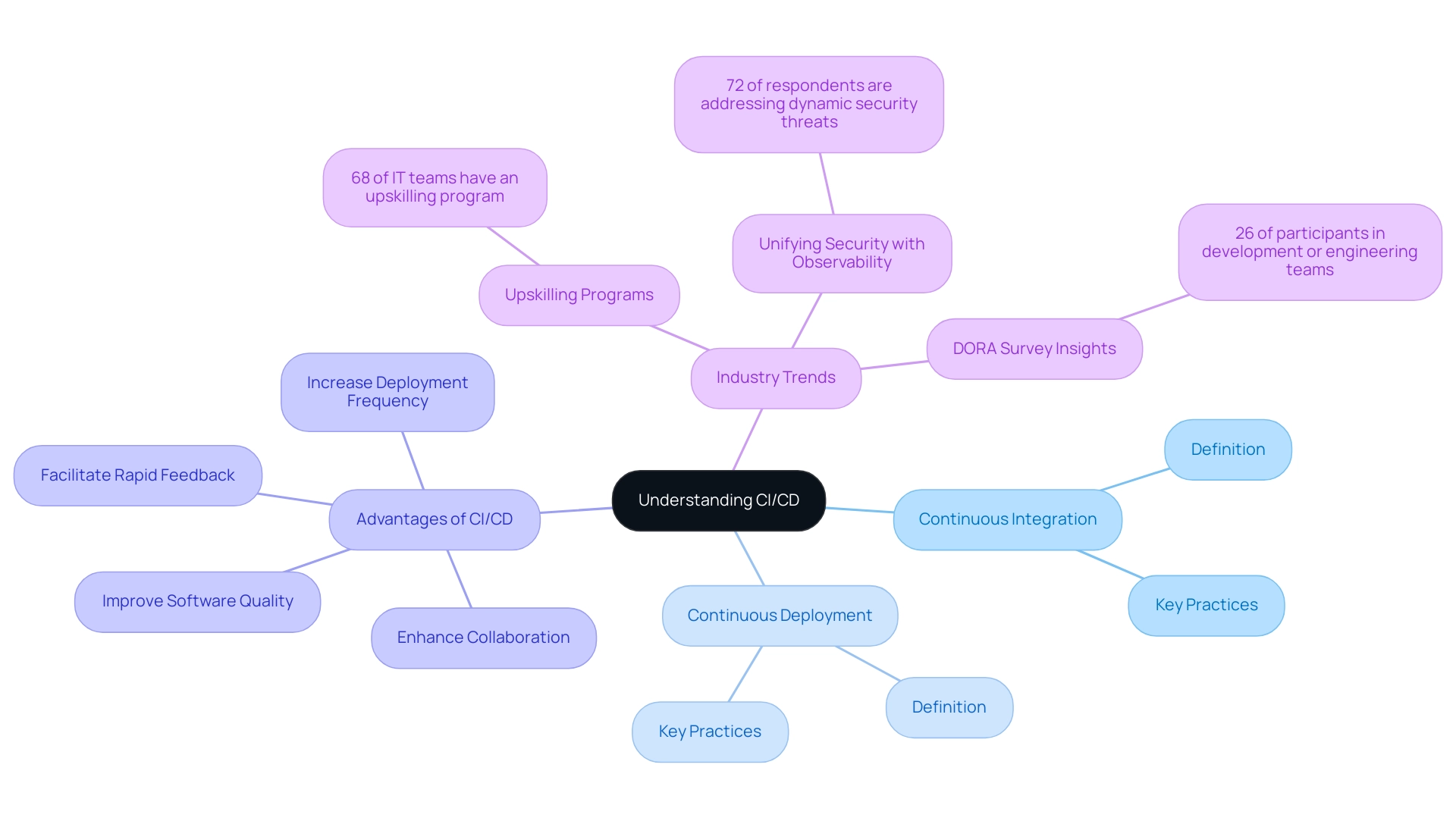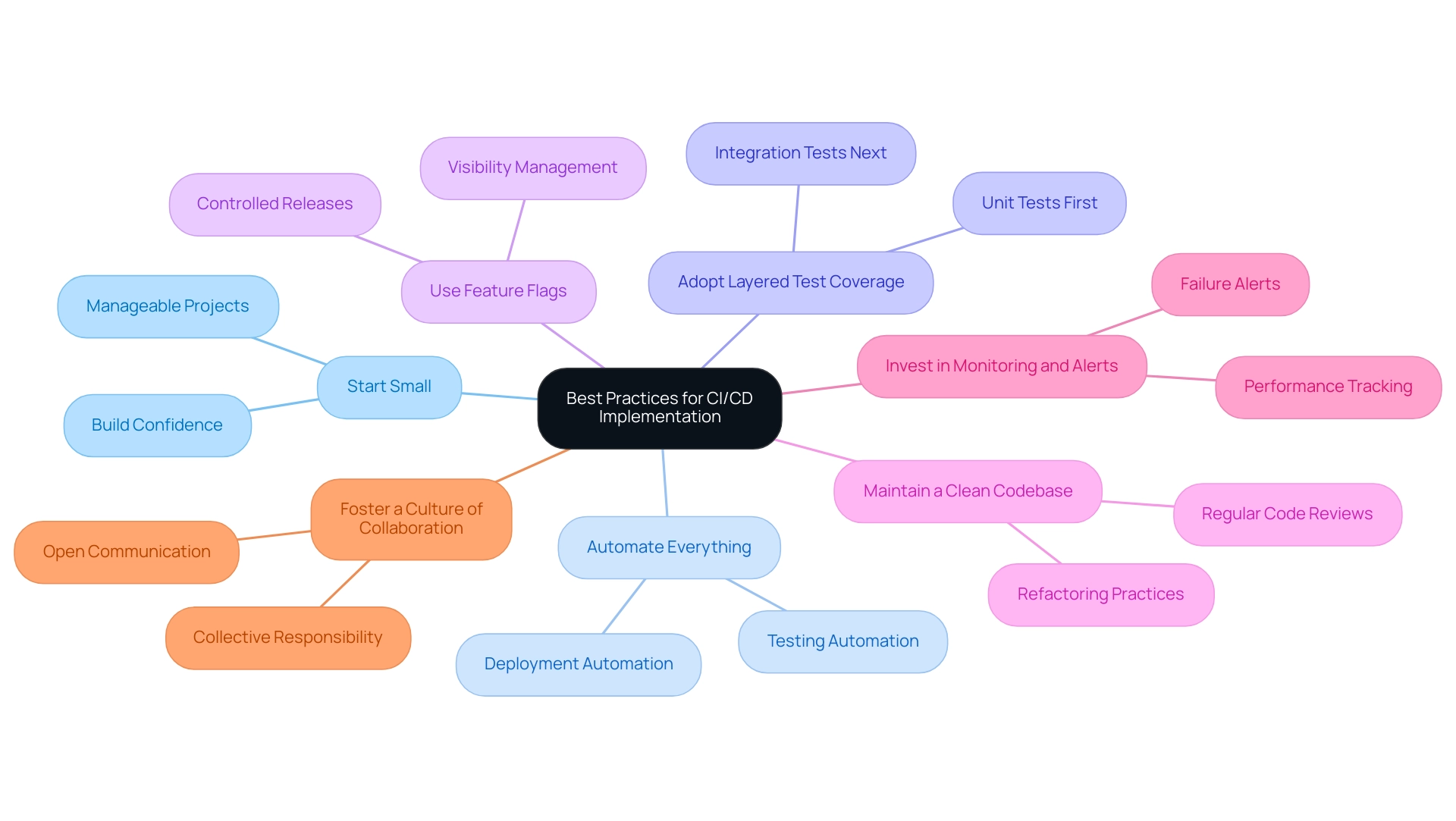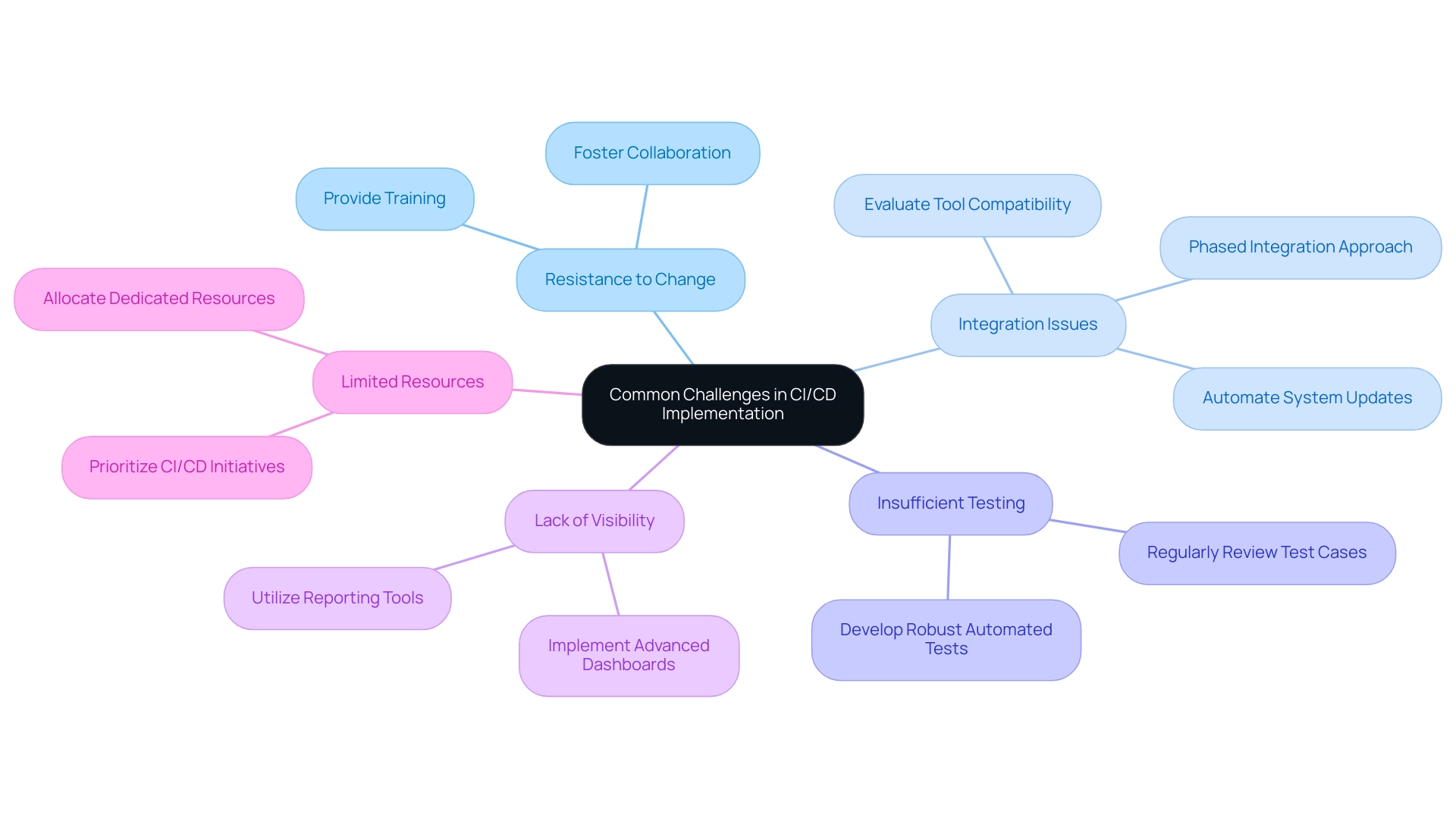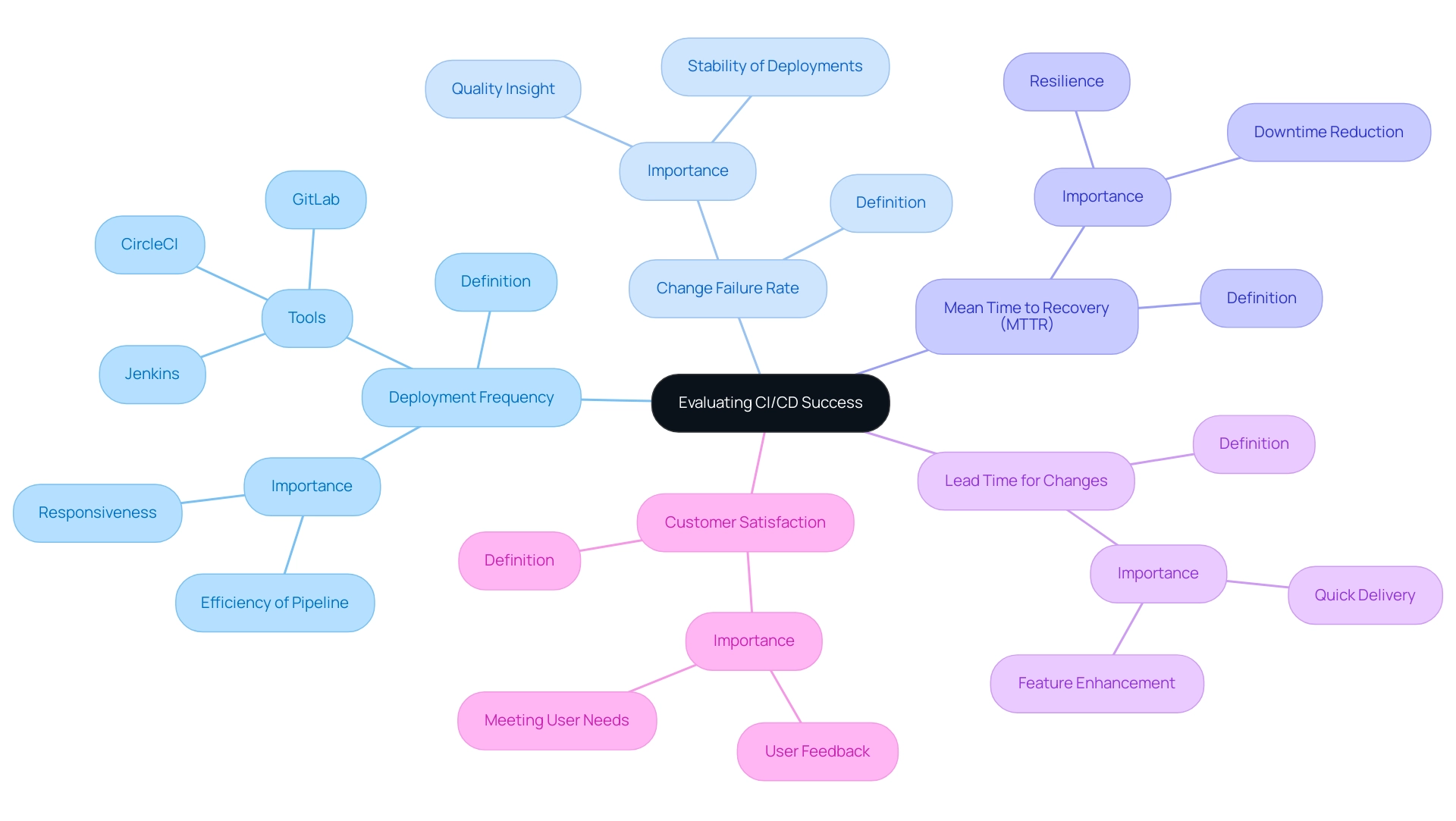Introduction
In the rapidly evolving landscape of software development, the adoption of Continuous Integration and Continuous Deployment (CI/CD) methodologies has emerged as a critical strategy for organizations aiming to enhance their efficiency and responsiveness. These practices not only streamline the development process but also foster a culture of collaboration and innovation among teams.
By automating code integration and deployment, organizations can significantly reduce the time it takes to deliver new features and updates, while simultaneously improving software quality through continuous testing. This article delves into the fundamental concepts of CI/CD, outlines a step-by-step guide for establishing a robust pipeline, and explores best practices to ensure successful implementation.
Furthermore, it addresses common challenges faced during the transition to CI/CD and offers insights on how to evaluate the effectiveness of these practices. As the demand for rapid software delivery continues to grow, understanding and mastering CI/CD is essential for any organization looking to maintain a competitive edge.
Understanding CI/CD: Key Concepts and Importance
Continuous Integration (CI) is the systematic approach of automatically merging code changes from multiple contributors into a shared repository multiple times a day. This methodology is instrumental in identifying integration issues at an early stage, thereby minimizing bugs and facilitating smoother development cycles. Continuous Deployment (CD) takes this a step further by automating the release of validated code changes into production, ensuring that new features and fixes are delivered to users swiftly and reliably.
The importance of implementing CI/CD practices is paramount for modern software development. By embracing these methodologies, organizations can achieve several key advantages:
- Enhance Collaboration: Continuous Integration and Continuous Deployment cultivate a collaborative culture among development teams, as all members work on the same codebase and regularly integrate their changes, fostering teamwork and shared accountability.
- Increase Deployment Frequency: The automation inherent in Continuous Integration and Continuous Deployment allows teams to deploy code changes more frequently, significantly reducing the time-to-market for new features and updates.
- Improve Software Quality: Continuous testing and integration processes help detect issues early, resulting in higher-quality software and enhanced user satisfaction.
- Facilitate Rapid Feedback: Continuous Integration and Continuous Deployment pipelines enable immediate feedback on code changes, allowing teams to swiftly address issues and adapt to user requirements.
As the landscape of software development evolves, understanding these fundamental concepts is crucial for implementing CI/CD effectively. This foundation ensures that subsequent implementation steps are built upon a comprehensive understanding of continuous integration and delivery's importance and impact. Notably, a growing trend indicates that 68% of IT teams have an upskilling program in place, which aligns with the need for continuous learning related to continuous integration and continuous delivery practices.
Furthermore, 72% of respondents are actively working towards unifying security with observability and monitoring to tackle dynamic security threats, reflecting a broader shift in the industry towards integrating security practices within DevOps. Experts such as Cody Slingerland highlight this change, mentioning that 26% of respondents in Google’s Accelerate 2022 DevOps Research and Assessment (DORA) survey are part of development or engineering teams, emphasizing the vital role of continuous integration and delivery in improving collaboration and efficiency in these settings.

Step-by-Step Guide to Setting Up Your CI/CD Pipeline
Creating a strong system for implementing CI/CD requires a series of strategic actions customized to the specific needs of your organization. The subsequent recommendations will assist you in establishing an efficient continuous integration and continuous deployment system:
-
Choose the Right Tools: Selecting suitable tools for implementing CI/CD is paramount to aligning with your development environment and team dynamics. Consider leading platforms such as Jenkins, GitLab CI, CircleCI, and Travis CI, evaluating their features, integration capabilities, and community support to ensure a well-informed decision. Notably, GitLab CI/CD features include Auto DevOps, which scans projects and suggests templates for complete pipelines, streamlining your setup process.
-
Set Up a Version Control System: Implement a version control system (VCS) like Git to manage your codebase efficiently. Ensure that your team is well-versed in branching strategies and commit practices to maintain an organized and clean repository.
-
Create a Build Pipeline: Configure your CI tool to automate the build process. This typically involves outlining a build script that compiles the code, executes tests, and generates necessary artifacts. Ensure that the build process triggers automatically upon code changes by implementing CI/CD to foster a seamless workflow.
-
Implementing CI/CD: By integrating automated testing into your process, you can encompass unit tests, integration tests, and end-to-end tests. Consistent testing is crucial for early issue detection, enhancing the overall quality of your software.
-
Deploy to Staging: Establish a deployment procedure to a staging environment, which serves as a testing ground for further validation of code changes prior to production release. Utilizing tools like Docker or Kubernetes can significantly streamline the management of containerized deployments.
-
Configure Continuous Deployment: After confirming the staging procedure, set your workflow for continuous deployment. Automate the release workflow to production, ensuring that only thoroughly vetted code changes are deployed, thus maintaining system integrity.
-
Monitor and Optimize: After implementation, it's crucial to consistently oversee your continuous integration and continuous delivery process for performance and reliability. Utilize metrics to pinpoint bottlenecks and areas for enhancement, and optimize your workflows to boost efficiency and effectiveness. For example, Bitbucket Pipelines provides a free tier with 50 build minutes monthly, making it an economical choice for organizations seeking continuous integration and delivery solutions.
By following these organized steps, organizations can effectively establish a pipeline for implementing CI/CD, which not only simplifies development processes but also encourages teamwork and enhances software quality. This approach, particularly implementing CI/CD, is indispensable for a modern technology strategy, especially as DevOps specialists increasingly work across various departments and teams, driving innovation and responsiveness. Furthermore, demonstrating ROI and providing adaptable solutions can assist in persuading stakeholders of the value of investing in continuous integration and continuous delivery, particularly when dealing with budget limitations.

Best Practices for CI/CD Implementation
To achieve successful CI/CD implementation, organizations should consider the following best practices:
-
Start Small: Beginning your CI/CD workflow with a small, manageable project enables your team to learn and improve methods without the weight of excessive complexity. This strategic approach facilitates smoother transitions and builds confidence in the pipeline.
-
Automate Everything: Strive to automate as many tasks as possible, encompassing testing, building, and deployment. Automation not only minimizes human error but also ensures consistency across various environments, thereby enhancing reliability and efficiency in the development lifecycle.
-
Adopt Layered Test Coverage: Begin with unit tests, followed by integration or component tests. This layered approach to testing helps identify issues early, ensuring higher quality code and reducing the risk of failures in production.
-
Use Feature Flags: By implementing feature flags, teams can effectively manage the visibility of new features. This practice enables code deployment without exposing unfinished features to users, thus allowing for safer, more controlled releases.
-
Maintain a Clean Codebase: Regular code reviews and refactoring are essential for keeping the codebase maintainable. A clean codebase simplifies integration and deployment processes, significantly reducing the likelihood of issues arising during development.
-
Invest in Monitoring and Alerts: Establishing monitoring tools to track the performance of your continuous integration and continuous delivery pipeline is crucial. Implement alerts for failures or performance issues, ensuring that your team can respond promptly to any challenges that may arise.
-
Foster a Culture of Collaboration: Encourage open communication and collaboration between development, operations, and QA teams. A cooperative environment boosts the efficiency of continuous integration and continuous delivery methods and encourages collective responsibility for the codebase, ultimately resulting in better results.
By following these optimal methods, organizations can foster a strong environment for implementing CI/CD that not only facilitates ongoing enhancement but also promotes innovation in their development processes. As noted in the State of Continuous Integration and Continuous Delivery Report, there is a strong correlation between the number of DevOps technologies utilized by developers and their likelihood of being top performers. Adopting sophisticated continuous integration and continuous delivery tools and approaches, along with implementing CI/CD, is crucial for organizations to enhance their performance, especially for those currently behind despite using DevOps methodologies.
As Sacha Labourey states, "The State of Continuous Integration and Continuous Delivery Report serves as a crucial resource for organizations to understand the influence of these methodologies and modern technologies on their performance, highlighting emerging trends and optimal approaches." It also serves as an essential wake-up call, emphasizing a troubling trend where a substantial number of organizations are falling behind in performance despite widespread adoption of DevOps methods.

Common Challenges in CI/CD Implementation and How to Overcome Them
Organizations frequently encounter a variety of challenges when implementing CI/CD. Understanding these hurdles and developing effective strategies to overcome them is crucial for successful adoption. Here are some prevalent issues along with recommended solutions:
- Resistance to Change: A frequent obstacle is the hesitance of teams to adopt continuous integration and continuous delivery methods, often arising from a fear of the unfamiliar or possible interruptions to established workflows. Kumar et al. (2022) assess the maturity of DevOps practices in the software industry, indicating that fostering a collaborative environment is essential to overcoming this resistance.
To reduce this obstacle, it is crucial to provide thorough training and resources that clearly explain the advantages of continuous integration and continuous delivery, particularly in the context of implementing CI/CD and the specific steps involved.
- Integration Issues: The incorporation of current tools and systems into a continuous integration and continuous delivery process can present significant complexities. A thorough evaluation of current tools for compatibility is necessary, along with a phased integration approach to reduce disruption.
Moreover, managing system updates and security patches through automated methods or manual evaluations can facilitate this integration, ensuring that the shift to a new workflow is smooth and efficient.
- Insufficient Testing: Lack of adequate testing can lead to detrimental issues in production environments. Organizations must prioritize the development of robust automated tests that cover critical paths and edge cases.
Regular reviews and updates of test cases are vital to align with the evolving application, ensuring high quality and reliability.
- Lack of Visibility: Monitoring the continuous integration and continuous deployment process effectively can be challenging for many teams. Implementing CI/CD with advanced dashboards and reporting tools can provide essential insights into pipeline performance, failure rates, and deployment frequency, thereby enhancing transparency and facilitating timely decision-making.
Limited resources can pose a significant barrier to the successful adoption of continuous integration and continuous delivery practices. Liu et al. (2023) find that only around 10% of applications utilize continuous integration and continuous delivery technologies, underscoring the importance of overcoming these challenges.
To address this issue, organizations should prioritize implementing CI/CD initiatives and allocate dedicated resources specifically for maintaining and optimizing the pipeline. This focus will ensure that the continuous integration and continuous deployment systems operate efficiently and effectively.
By proactively addressing these challenges, organizations can significantly enhance their implementation efforts, leading to improved efficiency and competitiveness in a rapidly changing market environment. The case study on DevOps culture and collaboration shows that contemporary teams steer clear of silo approaches, ensuring the overall system meets swiftly evolving market demands, further highlighting the necessity for efficient continuous integration and delivery practices.

Evaluating the Success of Your CI/CD Implementation
To effectively evaluate the success of your CI/CD implementation, it is essential to focus on the following key metrics:
-
Deployment Frequency: This metric tracks how often code changes are deployed to production. Tools such as Jenkins, CircleCI, and GitLab offer comprehensive workflows that can assist in measuring deployment frequency. An increase in deployment frequency signifies a more efficient and responsive pipeline, which is critical in today’s fast-paced development landscape.
-
Change Failure Rate: Measuring the percentage of changes that lead to failures in production provides insight into the quality and stability of deployments. A reduced change failure rate signifies a more resilient development and deployment approach, vital for upholding high software quality.
-
Mean Time to Recovery (MTTR): Assessing the average time taken to recover from production failures is crucial. A shorter MTTR indicates resilience in your continuous integration and delivery, enabling teams to tackle issues quickly and reduce downtime.
-
Lead Time for Changes: This metric calculates the time it takes for a code change to move from development to production. Shortened lead time is indicative of an effective continuous integration and delivery pipeline, facilitating quicker delivery of features and enhancements to users.
-
Customer Satisfaction: Gathering user feedback on the quality and frequency of releases is essential. Positive feedback indicates that the continuous integration and delivery process is effectively meeting user needs, which is vital for long-term success.
As Sacha Labourey noted, "The State of Continuous Integration/Continuous Deployment Report serves as a vital tool for organizations to grasp the impact of these practices and modern technologies on their performance, shedding light on emerging trends and best practices." This highlights the significance of these metrics in assessing the effectiveness of implementing CI/CD processes.
Consistently tracking these metrics allows organizations to identify strengths and weaknesses in implementing CI/CD. For example, in a case study on Continuous Integration Metrics Tracking, organizations that concentrated on metrics such as cycle time and time to value were able to enhance code quality and simplify development methods, ultimately improving software delivery processes.
This proactive approach not only fosters continuous improvement but also ensures alignment with overarching business objectives. As highlighted in the State of CI/CD Report, organizations that harness advanced CI/CD tools and practices can elevate their performance, transforming potential weaknesses into strengths.

Conclusion
Embracing Continuous Integration and Continuous Deployment (CI/CD) methodologies is essential for organizations striving to enhance their software development processes in today's fast-paced environment. By understanding the key concepts of CI/CD, teams can foster collaboration, increase deployment frequency, and improve software quality through systematic integration and testing. Establishing a robust CI/CD pipeline requires careful planning and execution, including the selection of appropriate tools, the implementation of automated testing, and the monitoring of performance metrics.
Successful CI/CD implementation hinges on adherence to best practices, such as:
- Starting small
- Automating processes
- Maintaining a clean codebase
By addressing common challenges—such as resistance to change and integration issues—organizations can streamline their transition to CI/CD and mitigate potential setbacks. Moreover, the ability to evaluate CI/CD effectiveness through key metrics ensures continuous improvement and alignment with business objectives.
As the demand for rapid software delivery intensifies, mastering CI/CD practices will not only enhance an organization's competitiveness but also foster a culture of innovation and responsiveness. The journey towards a successful CI/CD implementation is ongoing, requiring dedication to refining processes and embracing new technologies. Ultimately, those who invest in these methodologies will find themselves better equipped to meet the ever-evolving demands of the software development landscape.




